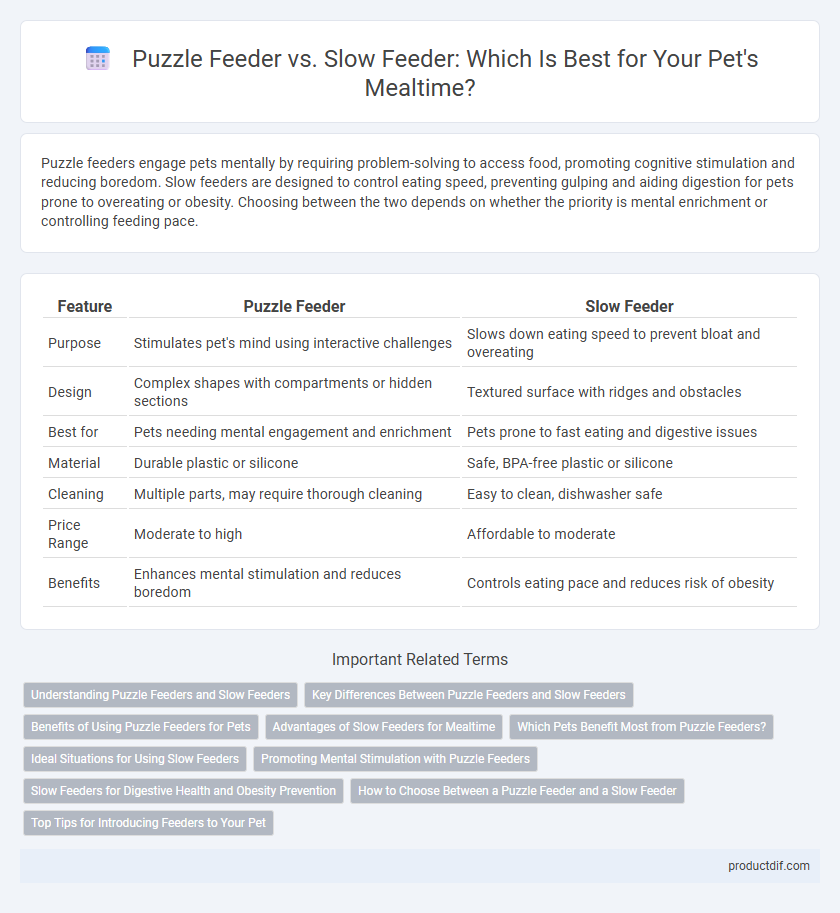Puzzle feeders engage pets mentally by requiring problem-solving to access food, promoting cognitive stimulation and reducing boredom. Slow feeders are designed to control eating speed, preventing gulping and aiding digestion for pets prone to overeating or obesity. Choosing between the two depends on whether the priority is mental enrichment or controlling feeding pace.
Table of Comparison
| Feature | Puzzle Feeder | Slow Feeder |
|---|---|---|
| Purpose | Stimulates pet's mind using interactive challenges | Slows down eating speed to prevent bloat and overeating |
| Design | Complex shapes with compartments or hidden sections | Textured surface with ridges and obstacles |
| Best for | Pets needing mental engagement and enrichment | Pets prone to fast eating and digestive issues |
| Material | Durable plastic or silicone | Safe, BPA-free plastic or silicone |
| Cleaning | Multiple parts, may require thorough cleaning | Easy to clean, dishwasher safe |
| Price Range | Moderate to high | Affordable to moderate |
| Benefits | Enhances mental stimulation and reduces boredom | Controls eating pace and reduces risk of obesity |
Understanding Puzzle Feeders and Slow Feeders
Puzzle feeders engage pets by requiring problem-solving skills to access food, promoting mental stimulation and reducing boredom during mealtime. Slow feeders are designed with ridges or obstacles to physically slow down eating speed, helping to prevent digestive issues like bloating and improve portion control. Both tools enhance feeding habits but target different aspects of pet health; puzzle feeders challenge cognition, while slow feeders regulate pace and digestion.
Key Differences Between Puzzle Feeders and Slow Feeders
Puzzle feeders require pets to solve problems or manipulate parts to access food, promoting mental stimulation and engagement, while slow feeders primarily focus on reducing eating speed through physical barriers in the bowl design. Puzzle feeders often contain multiple compartments or removable pieces that challenge pets to work for treats, enhancing cognitive skills compared to slow feeders that merely extend mealtime. Slow feeders are typically simpler, aimed at preventing gulping and reducing risks of bloating, whereas puzzle feeders combine feeding with play, offering enriched feeding experiences.
Benefits of Using Puzzle Feeders for Pets
Puzzle feeders stimulate pets mentally by challenging them to solve problems to access their food, promoting cognitive development and reducing boredom. They encourage slower eating, which aids digestion and helps prevent obesity and related health issues. This interactive feeding method also supports natural foraging behaviors, contributing to overall behavioral enrichment and improved well-being.
Advantages of Slow Feeders for Mealtime
Slow feeders promote healthier eating habits by reducing the risk of choking and bloat in pets, especially dogs, through controlled food intake. These feeders also help improve digestion and prevent obesity by minimizing rapid gulping and encouraging prolonged chewing. Designed with various patterns and sizes, slow feeders cater to different breeds and dietary needs, making them an effective tool for maintaining optimal pet health during mealtime.
Which Pets Benefit Most from Puzzle Feeders?
Puzzle feeders are ideal for highly intelligent and active pets such as dogs, cats, and even small mammals like rabbits, as they stimulate mental engagement and reduce boredom during mealtime. Pets prone to obesity or fast eating benefit from the challenge of extracting food, which promotes slower consumption and aids digestion. Species with natural foraging instincts, including certain dog breeds like Border Collies and working cats, gain significant enrichment and improved behavioral health through puzzle feeders.
Ideal Situations for Using Slow Feeders
Slow feeders are ideal for pets prone to rapid eating, such as dogs with a history of bloat or digestive issues, as they help regulate meal pace and improve digestion. They are especially beneficial for overweight pets, encouraging portion control and preventing overeating by making mealtime more challenging. Slow feeders also support mental stimulation and stress reduction in anxious or bored pets by prolonging feeding time and engaging their problem-solving skills.
Promoting Mental Stimulation with Puzzle Feeders
Puzzle feeders provide interactive challenges that enhance pets' cognitive skills by requiring problem-solving to access food, significantly promoting mental stimulation. Unlike slow feeders that mainly control eating speed through physical barriers, puzzle feeders engage pets in activities that encourage critical thinking and prolong mealtime enjoyment. This mental engagement not only reduces boredom and anxiety but also helps improve a pet's overall behavioral health.
Slow Feeders for Digestive Health and Obesity Prevention
Slow feeders are specifically designed to regulate a pet's eating pace, which promotes better digestion and reduces the risk of obesity by preventing overeating. By encouraging pets to chew their food thoroughly and consume smaller amounts over time, slow feeders help minimize digestive issues such as bloating and indigestion. These feeding tools are especially effective for dogs and cats prone to rapid eating, supporting long-term health and weight management.
How to Choose Between a Puzzle Feeder and a Slow Feeder
Choosing between a puzzle feeder and a slow feeder depends on your pet's mental stimulation needs and eating habits. Puzzle feeders engage pets in problem-solving by requiring them to manipulate parts to access food, promoting cognitive development and reducing boredom. Slow feeders primarily focus on controlling eating speed through maze-like designs, helping prevent gulping and digestive issues without the complexity of puzzles.
Top Tips for Introducing Feeders to Your Pet
When introducing puzzle feeders and slow feeders to your pet, start by selecting a feeder size and design that matches your pet's breed and eating habits to encourage natural foraging behavior. Gradually increase the difficulty level and monitor your pet's response to prevent frustration or disinterest, ensuring a positive feeding experience. Consistency in feeding times paired with rewarding your pet for interaction helps build engagement and promotes slower, healthier eating habits.
Puzzle feeder vs Slow feeder Infographic

 productdif.com
productdif.com